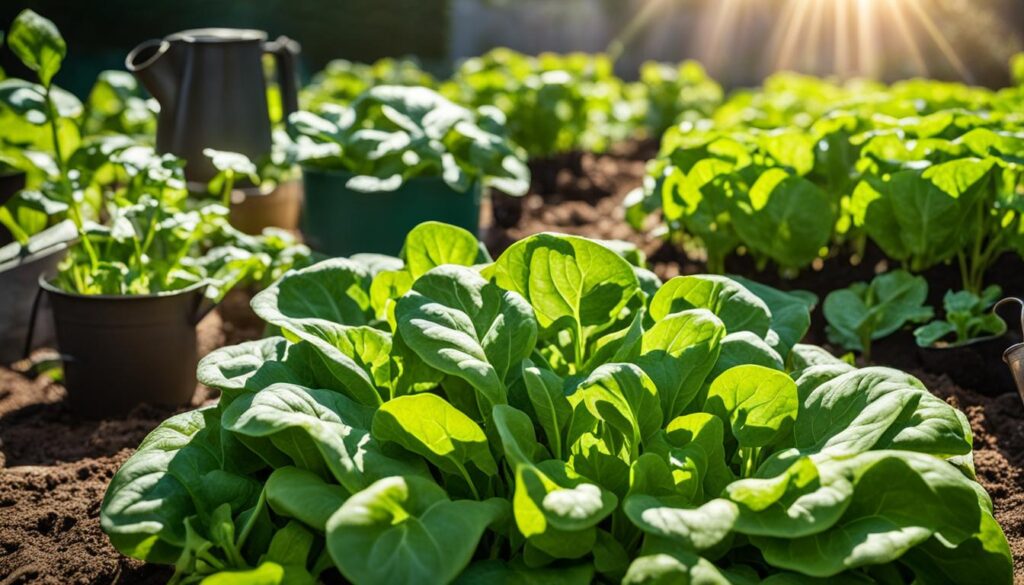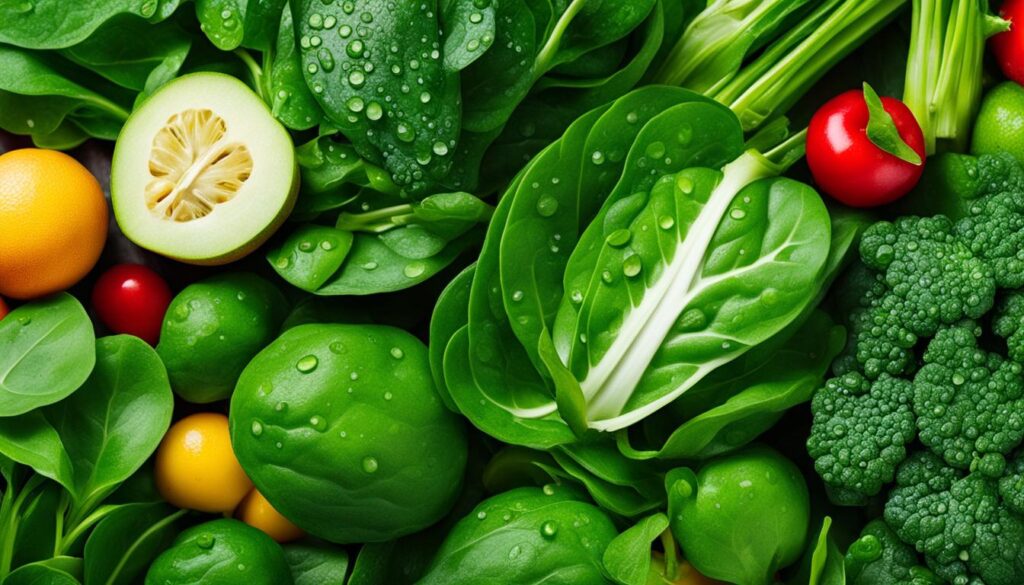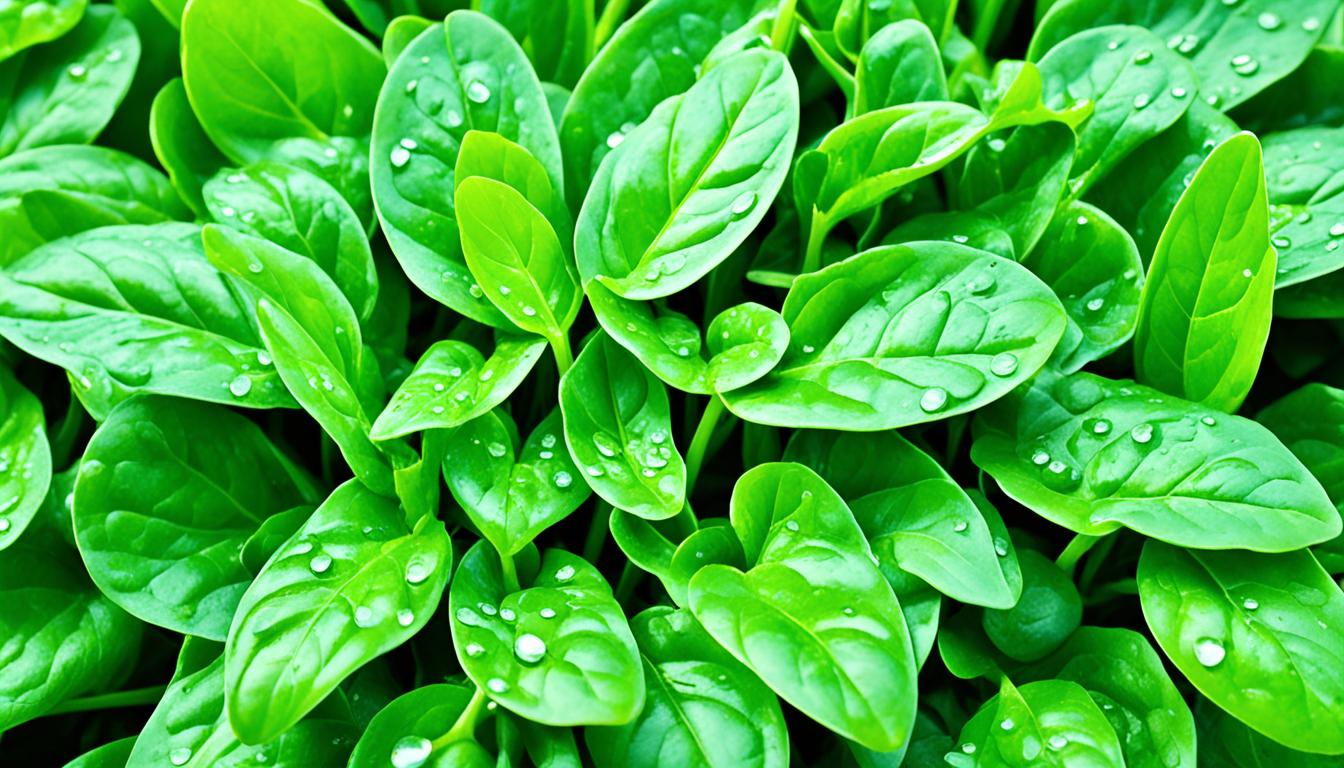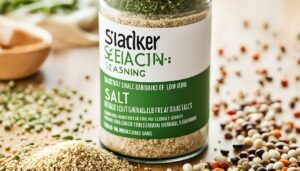Did you know that longevity spinach, a leafy green vegetable, is hailed as a superfood with incredible health benefits? This powerhouse plant is not only delicious but also packs a punch when it comes to nourishing your body and promoting overall well-being.
Whether you’re looking to boost your immune system, support heart health, or enhance digestive wellness, longevity spinach has got you covered. In this article, we will explore the remarkable health benefits of longevity spinach and discover how this versatile leaf can make a positive impact on your daily diet.
Key Takeaways:
- Longevity spinach is a superfood packed with health benefits.
- It supports immune function, heart health, and digestive wellness.
- Incorporating longevity spinach into your diet can enhance overall well-being.
- This leafy green vegetable is versatile and can be easily incorporated into various recipes.
- Consider growing longevity spinach in your own garden for a fresh and sustainable supply.
Demystifying Longevity Spinach: What Is It Good For?
In this section, we will explore the unique characteristics of longevity spinach and its various applications. Let’s delve into the distinct attributes that set it apart from common spinach varieties, uncover its cultural significance and naming conventions, and discover its traditional medicinal uses.
Characteristics of Longevity Spinach vs. Common Spinach Varieties
Longevity spinach, scientifically known as Gynura procumbens, is a perennial leafy vegetable that belongs to the Asteraceae family. Unlike common spinach varieties, longevity spinach has distinct characteristics that make it a unique and sought-after plant.
Here are some key differences:
- Longevity spinach has elongated leaves with serrated edges, compared to the smooth, round leaves of common spinach.
- The leaves of longevity spinach are rich in antioxidants, specifically flavonoids and phenolic compounds, which contribute to its exceptional health benefits.
- It has a pleasant, mildly bitter taste that adds a unique flavor to dishes.
- Longevity spinach is known for its ability to thrive in diverse climates and environments, making it a resilient option for home gardeners.
Cultural Significance and Naming
Longevity spinach holds cultural significance in various traditional cuisines and medicinal systems. In Southeast Asian countries like Malaysia, Indonesia, and Thailand, it is commonly used in culinary preparations and is integrated into local diets.
The plant is often referred to by different names in different cultures. For example, in Malaysia, it is known as “Daun Dewa,” which translates to “Leaf of the Gods,” highlighting its revered status in traditional wellness practices.
Longevity Spinach’s Medicinal Uses
Longevity spinach has a rich history of traditional medicinal uses across different cultures. It is believed to possess various beneficial properties that contribute to overall well-being.
Some of the traditional medicinal uses of longevity spinach include:
- Anti-inflammatory properties: Longevity spinach has been used to reduce inflammation in the body and alleviate symptoms associated with conditions such as arthritis.
- Improved digestive health: The fiber content in longevity spinach supports healthy digestion and may help relieve constipation.
- Blood sugar regulation: Studies have shown that longevity spinach may help regulate blood sugar levels, making it potentially beneficial for individuals with diabetes.
- Heart health support: The antioxidants present in longevity spinach contribute to cardiovascular health by reducing oxidative stress and supporting healthy blood pressure levels.
These traditional uses highlight the potential of longevity spinach as a natural remedy for various health concerns.
| Characteristics | Longevity Spinach | Common Spinach |
|---|---|---|
| Taste | Mildly bitter | Mild and slightly sweet |
| Leaf shape | Elongated with serrated edges | Round and smooth |
| Antioxidant content | High in flavonoids and phenolic compounds | Lower antioxidant content |
| Climate adaptability | Thrives in diverse climates | Less adaptable |
Longevity Spinach Benefits: Outlive the Science
In this section, we will uncover the remarkable health benefits of longevity spinach. This super leaf, also known as Gynura procumbens, is gaining popularity due to its numerous advantages for overall well-being. From its antioxidant power and nutrient profile to its potential impact on heart health, brain health, and digestive wellness, longevity spinach is a powerhouse of benefits that can enhance your daily life.
Antioxidant Power and Nutrient Profile
Longevity spinach is packed with antioxidants, compounds that help neutralize harmful free radicals in the body. The antioxidants found in this leafy green, such as flavonoids and phenolic compounds, contribute to its vibrant green color and play a significant role in promoting health and longevity.
Not only is longevity spinach rich in antioxidants, but it also boasts an impressive nutrient profile. It is an excellent source of vitamins A and C, providing essential immune support and promoting healthy skin. Additionally, it contains minerals like potassium, calcium, and iron, which are important for maintaining optimal bodily functions.
Longevity Spinach for Heart and Brain Health
The benefits of longevity spinach extend to heart health and brain function. The antioxidants present in this super leaf help protect cardiovascular health by reducing oxidative stress and inflammation, two key factors contributing to heart disease.
Furthermore, the consumption of longevity spinach is associated with improved brain health. The abundance of antioxidants and other bioactive compounds in this leafy green may help protect against age-related cognitive decline and support a healthy brain as we age.
Supporting Digestive Wellness with Fiber
Fiber is a crucial component of a healthy diet, and longevity spinach is an excellent source of this dietary fiber. Consumption of fiber-rich foods like longevity spinach can support digestive wellness by promoting regular bowel movements, preventing constipation, and supporting a healthy gut microbiome.
The fiber content in longevity spinach aids in maintaining a healthy weight, as it contributes to feelings of fullness and helps regulate blood sugar levels. Including this super leaf in your diet can help support a well-functioning digestive system and overall gastrointestinal health.

Cultivating Longevity Spinach in Your Garden
When it comes to growing your own longevity spinach, a little knowledge goes a long way. By following these tips and guidelines, you can ensure a successful cultivation and optimal yield of this nutritious super leaf.
Longevity Spinach Growing Tips and Climatic Requirements
Longevity spinach thrives in warm and tropical climates, but it can also be grown in temperate regions with proper care. Here are some essential growing tips:
- Choose a sunny location in your garden with well-drained soil.
- Plant longevity spinach in early spring or summer, when temperatures are consistently above 70°F (21°C).
- Provide the plant with adequate water, ensuring the soil remains moist but not overly saturated.
- Apply a layer of organic mulch around the base of the plants to help retain soil moisture and suppress weeds.
- Regularly check for pests and diseases, and take appropriate measures to protect your plants.
By following these growing tips and providing the right climatic conditions, you can create an ideal environment for your longevity spinach to flourish.
From Seeds to Harvest: A Guide to Cultivation
Now that you know the growing tips, let’s take a step-by-step look at how to cultivate longevity spinach:
- Start by soaking the longevity spinach seeds in water for 24 hours before planting.
- Sow the seeds directly into the prepared garden bed, spacing them about 6 inches apart.
- Cover the seeds lightly with soil, ensuring they are still visible.
- Water the seeds gently to keep the soil moist during the germination process.
- Once the seedlings have emerged, thin them out, keeping the strongest plants about 12 inches apart.
- Continue to water and care for the plants, ensuring they receive adequate sunlight and nutrients.
- Harvest the leaves as needed, starting from the outer leaves and working your way inward.
With patience and proper care, you will soon enjoy a bountiful harvest of fresh and nutritious longevity spinach.
Longevity Spinach Plant Care for Optimal Yield
To ensure an optimal yield of longevity spinach, it is important to provide consistent care to your plants:
- Water regularly, keeping the soil consistently moist but not waterlogged.
- Fertilize the plants every four to six weeks with a balanced organic fertilizer.
- Prune any damaged or yellowing leaves to promote new growth.
- Monitor for pests and diseases, and take appropriate action if necessary.
By giving your longevity spinach the care it needs, you can maximize its growth and harvest a plentiful supply of nutrient-packed leaves.

Nutritional Value of Longevity Spinach for Daily Diets
Understanding the Nutrient Density of Longevity Spinach
When it comes to achieving optimal nutrition, longevity spinach is a must-add to your daily diet. This super leaf packs a powerful punch of nutrients that can support your overall well-being.
Longevity spinach is known for its impressive nutrient density. It is rich in vital vitamins and minerals, including vitamin A, vitamin C, iron, calcium, and potassium. These nutrients play essential roles in maintaining a healthy immune system, promoting bone health, supporting cardiovascular function, and ensuring proper muscle and nerve function.
In addition to its wide array of vitamins and minerals, longevity spinach is also a great source of dietary fiber. Fiber is crucial for maintaining a healthy digestive system and promoting feelings of fullness, which can aid in weight management.
Furthermore, longevity spinach is low in calories and fat, making it a perfect addition to any balanced diet. Whether you’re looking to maintain a healthy weight or simply nourish your body with nutrient-rich foods, longevity spinach delivers on both fronts.
Incorporating Longevity Spinach into Healthy Recipes
Now that you understand the nutrient density of longevity spinach, it’s time to explore some delicious and healthy recipes that incorporate this super leaf.
Longevity spinach can be enjoyed in various ways, adding a touch of vibrancy and nutrition to your meals. Here are a few ideas to get you started:
- Longevity Spinach Salad: Toss fresh longevity spinach leaves with cherry tomatoes, cucumber slices, and a drizzle of olive oil and lemon juice for a refreshing and nutritious salad.
- Sautéed Longevity Spinach: Heat a drizzle of olive oil in a skillet and sauté longevity spinach with garlic until wilted. Season with a pinch of salt and pepper for a simple yet flavorful side dish.
- Longevity Spinach Smoothie: Blend longevity spinach leaves with your favorite fruits, such as banana and berries, along with unsweetened almond milk for a nutrient-packed smoothie to start your day.
- Longevity Spinach Stir-Fry: Add longevity spinach to a stir-fry with colorful vegetables, lean protein like chicken or tofu, and a splash of soy sauce for a nutritious and satisfying meal.
These are just a few ideas to inspire you to incorporate longevity spinach into your healthy recipes. Get creative and experiment with different flavor combinations to enjoy the full benefits of this nutrient-dense super leaf.

Adverse Effects: Understanding Longevity Spinach Side Effects
While longevity spinach offers numerous health benefits, it is essential to be aware of any potential side effects or precautions associated with its consumption. Although generally considered safe for most individuals, certain individuals may experience adverse reactions. By understanding the possible side effects, you can make informed decisions about incorporating longevity spinach into your diet.
One of the primary concerns related to longevity spinach is the oxalic acid content. Oxalic acid is a natural compound found in many leafy greens and vegetables, including spinach. When consumed in excess, it can form oxalate crystals in the body and contribute to the development of kidney stones. However, it’s important to note that the oxalate content in longevity spinach is relatively low compared to other high-oxalate foods.
Individuals who are susceptible to kidney stones or have a history of kidney problems should exercise caution when consuming longevity spinach. It is advisable to consult with a healthcare professional or a registered dietitian before incorporating this leafy green into your diet if you have pre-existing kidney issues.
Additionally, some individuals may experience gastrointestinal discomfort such as bloating, gas, or diarrhea after consuming longevity spinach. These symptoms are generally mild and temporary. However, if you notice persistent or severe digestive issues, it is recommended to limit or avoid longevity spinach consumption and consult a healthcare professional.
It’s worth noting that everyone’s body is unique, and individuals may react differently to specific foods or ingredients. If you have any known allergies or sensitivities, it’s important to be mindful when introducing longevity spinach into your diet.

To summarize, while longevity spinach offers a plethora of health benefits, it is crucial to be aware of any potential side effects. If you have pre-existing kidney issues, it is advisable to exercise caution when consuming longevity spinach due to its oxalate content. Additionally, individuals may experience mild gastrointestinal discomfort in some cases. If you have any concerns or experience adverse reactions after consuming longevity spinach, consult with a healthcare professional for personalized guidance.
Conclusion
The Superfood Potential of Longevity Spinach in Wellness Routines
In conclusion, we have discovered the incredible superfood potential of longevity spinach and its role in enhancing wellness routines. This nutrient-packed green leafy vegetable is a powerhouse of health benefits, making it a valuable addition to your daily diet.
By embracing a diet rich in longevity spinach and other nutrient-packed greens, you can experience long-term health benefits. The antioxidant power and nutrient density of longevity spinach not only support overall well-being but also contribute to heart and brain health. Additionally, its fiber content aids in promoting digestive wellness.
When considering your long-term health, incorporating longevity spinach into your wellness routine is a natural and effective choice. Its unique characteristics, cultural significance, and traditional medicinal uses further highlight its importance in maintaining a healthy lifestyle.
So, why wait? Start reaping the benefits of longevity spinach today and take a proactive step towards a healthier and more vibrant future.




